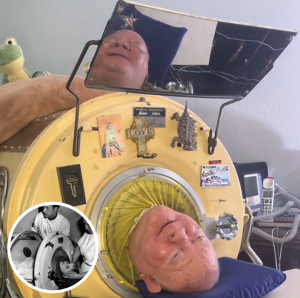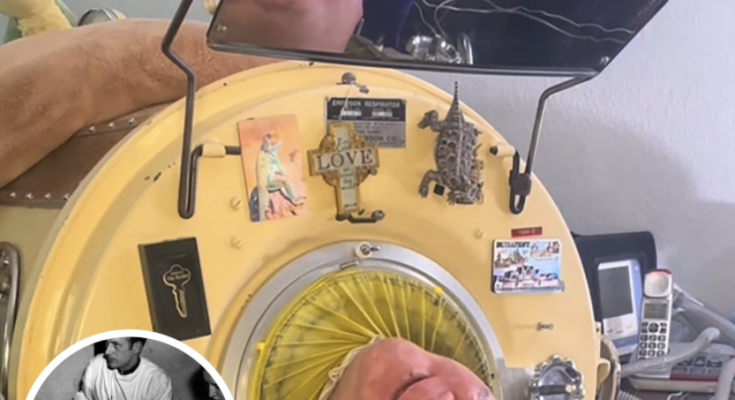Man Who Spent 70 Years in an Iron Lung Passes Away
For more than seven decades, one man’s life stood as a remarkable testament to human resilience, technological ingenuity, and the sheer will to keep moving forward in the face of unimaginable hardship. Paul Alexander, often known simply as “the man in the iron lung,” passed away this year at the age of 78, closing a chapter that began in the earliest years of the polio epidemic in America and extended deep into the 21st century. His story is not just one of medical history—it is one of survival, adaptation, and inspiration for generations who watched him live and thrive despite immense obstacles.
Childhood Interrupted by Polio
Paul Alexander was just six years old when his life changed forever. Born in 1946 in Dallas, Texas, he was an energetic, lively child. Like countless other kids in mid-20th century America, he ran through backyards, played with neighborhood friends, and dreamed of a future wide open with possibilities. But in the summer of 1952, when the polio virus swept through Texas, Alexander fell ill.
What began as a fever and sore throat quickly turned into something far more sinister. Within days, he lost the ability to move or breathe on his own. He was rushed to the hospital, where doctors placed him into a mechanical respirator known as an “iron lung.” It was a massive, coffin-like metal cylinder that used negative pressure to help the lungs expand and contract. At that time, it was the only way to keep polio victims alive once the virus paralyzed the muscles needed for breathing.
Doctors didn’t think Alexander would survive the night. But he did—and not just the night, but the week, the month, and eventually the decades to come.
A Life in a Machine
Living in an iron lung was not simply about medical survival—it was a constant exercise in adaptation. The device encased his entire body from the neck down, leaving only his head exposed. Air was mechanically pumped in and out of the chamber, allowing his chest to rise and fall. He could not move freely, could not leave the machine for more than a few minutes, and required assistance for almost every basic task.
And yet, Alexander refused to be defined by the limitations. Over the years, he found ways to pursue education, friendships, and even a career. With painstaking determination, he taught himself to “frog breathe,” a technique of gulping air into his lungs using throat muscles. This skill allowed him to spend short periods outside the iron lung—long enough to study, attend classes, and eventually earn degrees.
Education and Career
Despite his disability, Alexander was ambitious. He attended high school with the help of friends and teachers who carried books and took notes for him. Later, he enrolled at Southern Methodist University and eventually earned a law degree from the University of Texas at Austin.
Practicing law was no small feat. He could not type in the traditional sense, so he used a pen strapped to a stick held in his mouth to draft legal documents. His resilience and intellect earned him respect in the legal community, and he built a career representing clients in court and writing legal briefs—all while relying on the iron lung at night to breathe.
Alexander’s life shattered stereotypes of what was possible for people with severe disabilities. At a time when accessibility laws and disability rights were still decades away, he carved a path that demonstrated not only survival but also achievement.
A Symbol of the Polio Generation
For many, Alexander became a living symbol of the era when polio was the most feared disease in America. Before the widespread introduction of the polio vaccine in the mid-1950s, tens of thousands of children were paralyzed or killed each year by the virus. Iron lungs filled hospital wards, and the sight of rows of children encased in the machines became one of the defining images of the epidemic.
When the vaccine all but eliminated polio in the United States, most of those machines disappeared. But Alexander remained—one of the very last people on earth still dependent on an iron lung. His very existence was a reminder of both how far medical science had come and of the lives that had been permanently altered before the vaccine.
Sharing His Story
In his later years, Alexander began to share more openly about his experience. He wrote a memoir, Three Minutes for a Dog: My Life in an Iron Lung, published in 2020. In the book, he chronicled not just the struggles of his condition but also the joys, friendships, romances, and accomplishments that defined his life.
Social media and online communities also discovered his story, and he became something of an inspirational figure for younger generations. Videos of him speaking from his iron lung went viral, and he often spoke about the importance of gratitude, perseverance, and refusing to let circumstances dictate one’s identity.
“Just because you live in an iron lung doesn’t mean you can’t have a good life,” he once said. “It’s up to you to decide whether you’re going to sit there feeling sorry for yourself, or whether you’re going to make something of what you have.”
The End of an Era
Paul Alexander’s passing marks the end of an extraordinary chapter in medical and human history. By the time of his death, he had spent over 70 years in the iron lung—longer than anyone else in the world.
Friends, family, and admirers remember him not only for his resilience but for his warmth and humor. Despite the constant challenges, he greeted life with wit and determination. His story resonated globally, serving as a reminder of the fragility of life, the progress of science, and the enduring strength of the human spirit.
Legacy
Alexander’s life leaves behind several important legacies. First, it underscores the vital role vaccines have played in eradicating once-deadly diseases. His reliance on a now-obsolete machine stands as a haunting reminder of what polio once did to entire generations.
Second, his story is a beacon for disability rights and accessibility. Long before society acknowledged the rights of the disabled, he proved through personal example that people with profound physical challenges could contribute meaningfully to society if given the chance.
Finally, his unyielding attitude continues to inspire. His life was not defined by tragedy but by triumph—triumph over limitations, triumph over expectations, and triumph over despair.
Conclusion
Paul Alexander’s journey was never an easy one. From a six-year-old boy struck down by polio to a lawyer, author, and figure of resilience, he lived a life both extraordinary and deeply human. Encased in steel but propelled by willpower, he proved that even the harshest constraints cannot extinguish the drive to live, to love, and to leave a legacy.
As the world remembers him, his iron lung may fall silent, but his story continues to breathe life into all who hear it.


